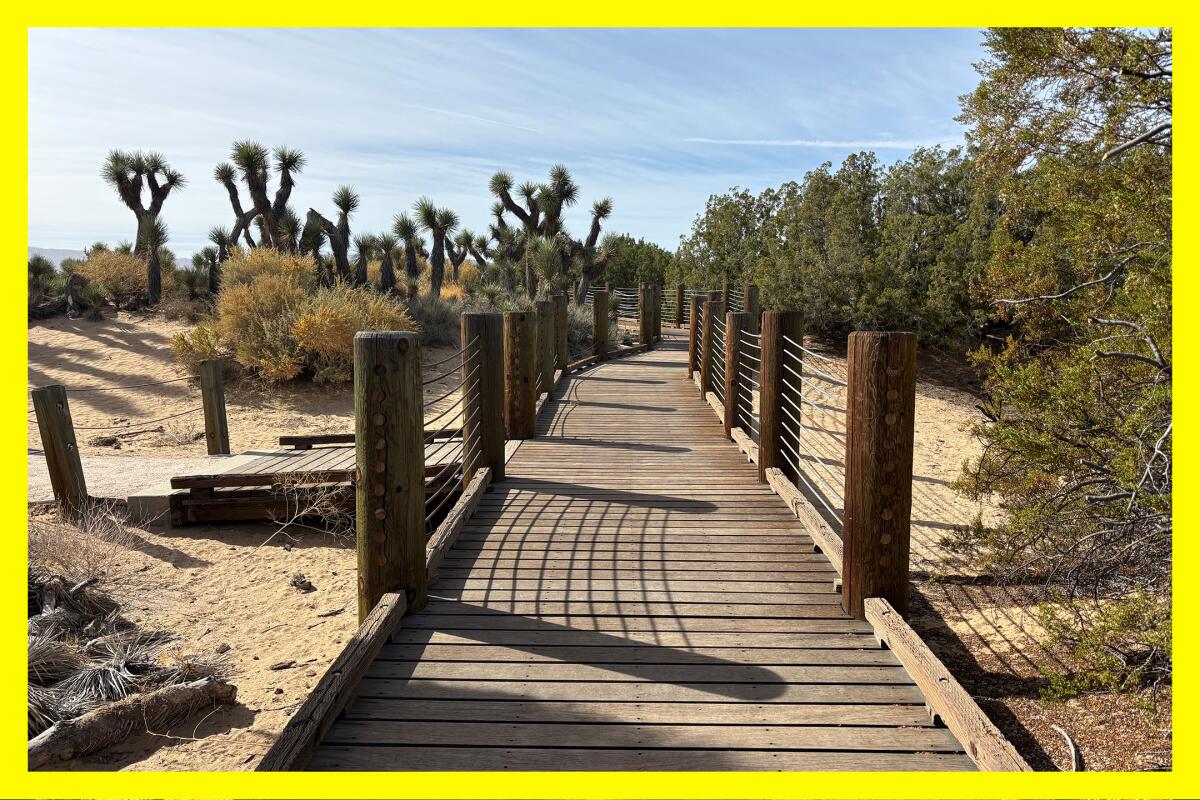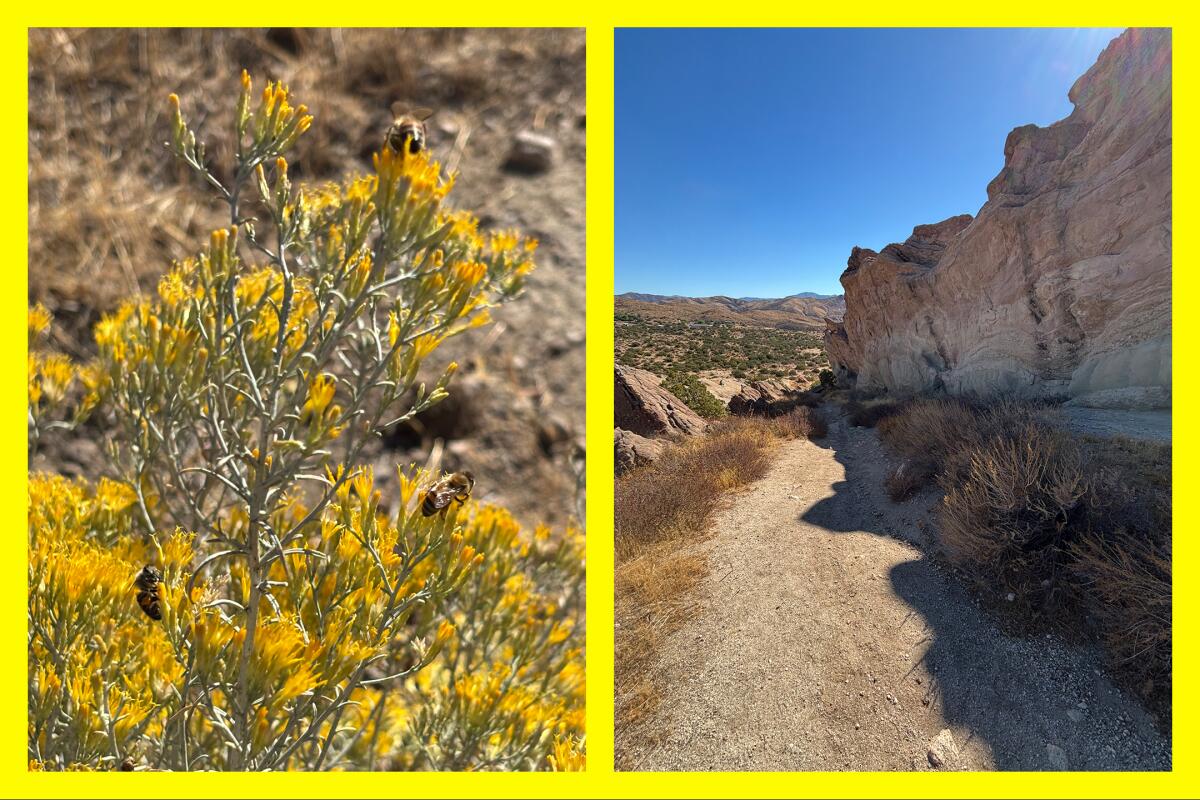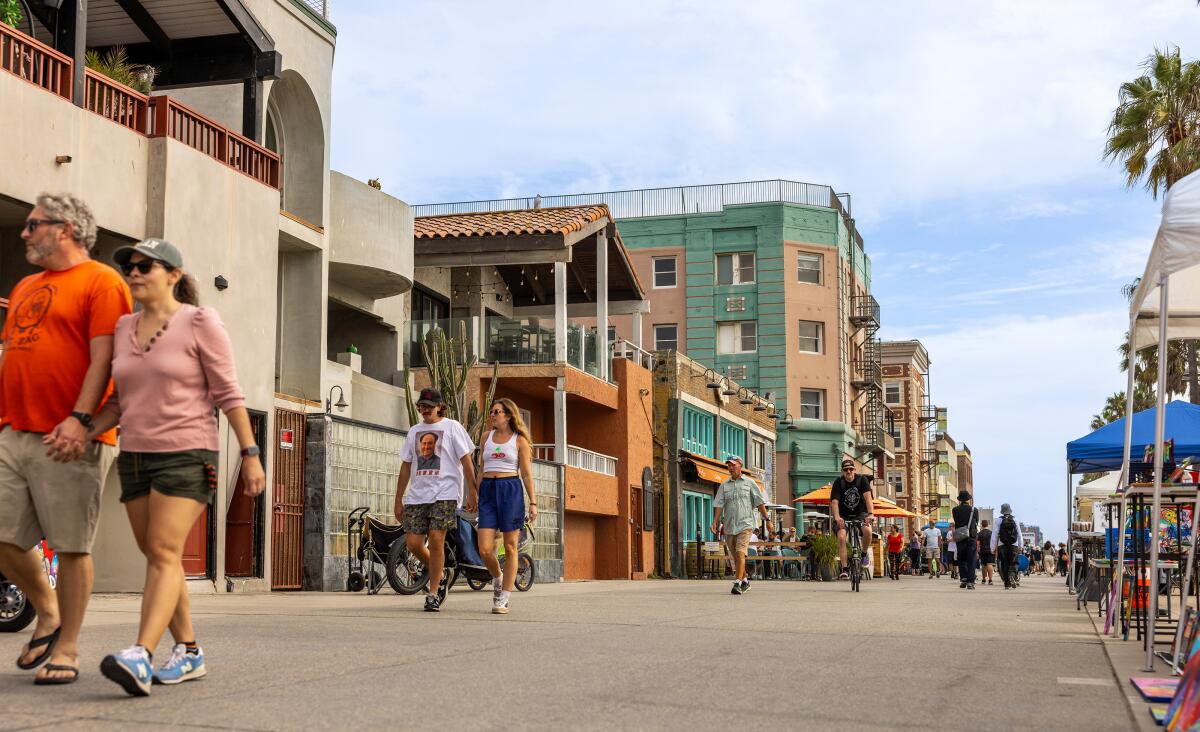Now is the time of year when I try not to brag too much about how great the weather is.
Soon enough, my friends back home in the South will start posting on social media about ice, snow and bitter wind. Meanwhile, here in L.A., our fall is Goldilocks weather — not too hot, not too cold, but just right. (In our fairy tale, you should also keep an eye out for bears.)
In other words, this is the ideal season to explore, and as the weather cools, go on an epic desert hike. And you don’t need to drive all the way out to Joshua Tree to do it.
Newsletter
You are reading The Wild newsletter
Sign up to get expert tips on the best of Southern California’s beaches, trails, parks, deserts, forests and mountains in your inbox every Thursday
You may occasionally receive promotional content from the Los Angeles Times.
I love, for example, exploring the high desert of the Antelope Valley, a 3,000-square mile region in northern L.A. County and southern Kern County.
There’s lots to love about a fall desert hike: cool crisp air, solitude, fascinating, alien-like plants and an abundance of geological wonders to observe. Personally I find a lot of comfort and connection as a queer person in a desert ecosystem. Take the California juniper. Despite drought and harsh winters, it makes use of its resources, and can survive whether it’s 10 or 110 degrees. Even in the harshest of conditions, it still thrives.
The three hikes below are a bit of a drive from L.A. It can take an hour and half from downtown L.A. to reach the farthest hikes on this list. But they’re all still closer than Joshua Tree, and will probably never be as crowded. Make the day of it. If you get up early enough, you might even be able to cross out more than one hike on this list. Just make sure to pack plenty of water, and both sun and wind protection.

The trails through Prime Desert Woodland Preserve feature sandy paths and wood bridges over a gentle landscape.
(Jaclyn Cosgrove / Los Angeles Times)
Prime Desert Woodland Preserve walking trail
Distance: 3 miles
Elevation gain: Minimal
Difficulty: Easy
The Prime Desert Woodland Preserve is a 120-acre open space in Lancaster that’s open daily from 6 a.m. to 10 p.m., weather permitting. The preserve includes the Elyze Clifford Interpretive Center, named after the environmentalist who championed desert preservation. Its programming is managed by the Lancaster Museum of Art and History and features educational displays on native plants and animals, and hosts young artist workshops where kids can create art inspired by the desert environment. The center is open weekends from 10 a.m. to 4 p.m. The museum also regularly hosts night hikes here.
Many animals call the preserve home, including the so-called desert wolf, also known as the coyote. Keep an eye out for a black-chinned hummingbird, cactus wren or California thrasher (of the feathered, not rock star, variety).

Joshua trees, which are part of the agave family, are abundant at Prime Desert Woodland Preserve in Lancaster.
(Jaclyn Cosgrove / Los Angeles Times)
You’ll notice California juniper and Joshua trees as you meander through the preserve. Although creosote brush is usually plentiful in the desert, the preserve has only one. But, preserve staff believe it may be the largest in the Antelope Valley. You can spot it near the appropriately named Creosote Loop Trail.
The preserve has three miles of hiking trails, with short loops throughout. After your adventure, consider checking out a restaurant in Lancaster. I’m partial to Ogla’s.

The formations at Vasquez Rocks are diverse in shape and color.
(Jaclyn Cosgrove / Los Angeles Times)
PCT and Apwinga Loop Trail at Vasquez Rocks Natural Area
Distance: 3.4 miles
Elevation gain: 600 feet
Difficulty: Moderate
The first time I visited Vasquez Rocks Natural Area, I drove up, explored its famous rocks that jut from the ground like massive flying saucers, and then left. But this park has more to offer than spots to reenact Captain Kirk’s fight with the Gorn in the original “Star Trek.”
To begin the loop, you can start at the gate after parking near the nature center (which features fun movie memorabilia of films made at Vasquez).
Follow the Pacific Crest Trail clockwise, or westerly, and you’ll soon find yourself with your first great view of the park, including its iconic slabs of earth. You’ll follow the trail as it passes next to large rocks — including one that resembles a T. Rex — before entering an open area with a green picnic table beneath a pepper tree. Continue following the PCT.
Soon, you’ll notice trail signs noting that you’re on both the PCT and the Apwinga Loop Trail. The PCT will eventually jag southwest. You will continue following the Apwinga Loop. Here you’ll see so much more than those big famous rocks: sweeping vistas, purple red rocks to scramble along, native desert plants, like buckwheat and yucca and — depending on when you visit — plenty of solitude.

At left, bees perch on a rabbitbush growing in Vasquez Rocks Natural Area. At right, the awe-inspiring jagged formations at Vasquez Rocks Natural Area provide shady spots to rest along the trail.
(Jaclyn Cosgrove / Los Angeles Times)
I enjoyed looking at the numerous rock formations and, like a high desert Rorschach test, deciding what I thought they looked like: a bolt screwed into the ground, stacks of vinyl records and pancakes. (Maybe I was getting hungry at that point.)
In terms of difficulty, this trail is firmly moderate. Parts of it are flat or gently sloping, but you will run into a few stretches where you will briefly huff your way up. You will walk near the 14 Freeway for a bit, but unlike the drivers, you’ll have a close-up view of these remarkable rocks, created over thousands of years by wind, rain and moving earth.
Vasquez Rocks has different hours depending on the season. From Nov. 1 to Feb. 28, it’s open from 8 a.m. to 5 p.m. Tuesday through Sunday. Its spring and summer hours, which run from March 1 to Oct. 31, are 8 a.m. to 7:30 p.m. Tuesday through Sunday.

Hiking along the Devil’s Chair trail, you can view massive rocks with deep crevices made by hundreds of years of weather and movement.
(Jaclyn Cosgrove / Los Angeles Times)
The Devils Chair Trail 😈🪑
Distance: 7.4 miles
Elevation gain: About 1,500 feet
Difficulty: Moderately challenging
Arriving at the Devil’s Punchbowl Natural Area, you will soon spot the park’s namesake: massive tilted hunks of sandstone and other geological formations that look like they’d be a rock climber’s dream.
I didn’t actually know what the devil’s chair was when I started this hike. I assumed it was going to be another formation. I had an incredible surprise ahead.
The first mile of this hike is arguably the hardest part, as you gain 500 feet in a mile.
You will see several burned and dead trees. This area was burned by the 2020 Bobcat fire and is still recovering. Meaning you should avoid it on especially windy days to so as not to be hit over the head, or worse, by a crispy trunk.
After the first mile, you’ll find a creek that, as of early November, was still flowing. As you hike along the trail, you’ll probably spot chipmunks and gray squirrels. I also heard and saw a variety of birds, including hawks, ravens, white-crowned sparrows and dark-eyed juncos (which are very cute).

At left, the narrow path that takes hikers to the Devil’s Chair lookout. At right, the Bobcat fire burned through the Devil’s Punchbowl Nature Area in 2020, killing many trees. The fire did not reach the actual punchbowl formation or Devil’s Chair.
(Jaclyn Cosgrove / Los Angeles Times)
There are patches of the trail where you will see what the region looked like before the fire. Occasionally, you might see the scant remains of pinyon pine. But despite the burn areas, this trail is still so worth it. There are so many different rock formations, orange, purple, green and gray, to see.
And you get incredible views of the desert below and mountains in the distance, including nearby Table Mountain in Angeles National Forest and Tehachapi Mountain in Kern County.
The end of the hike reminded me of a safer version of Angels Landing in Zion National Park. You will walk a narrow fenced path to a small boulder, surrounded by a short fence, that overlooks the valley below.
From your perch, you can listen to the whistling wind as you take in a panoramic view of massive rock formations below. If lucky, you might spot a bighorn sheep, which a staff member told me like to hang out in the cavern below. Watch where you step along this last part of the trail, as there are some holes in the bottom of the fence. Drop your cellphone here and it’s gone.
From here, you’ll gain about 300 feet as you return back from the devil’s chair. I was an in immense state of wonder at that point and didn’t mind the steep ascent after eating my lunch on one of the coolest lookout points in L.A. County.
While at the Devil’s Punchbowl Natural Area, make sure to check out the nature center. There are two female ravens who enjoy holding each other’s beaks — which I witnessed, and it was very sweet — and friendly staff who can answer your questions about the region. And there is a diabolical ironclad beetle, who staff say is not actually very diabolical and various snakes, including a chonky senior rattlesnake.
Speaking of, make sure to keep an eye out for rattlesnakes, although they’re far less active in the winter. A park staffer also told me that at least one mountain lion calls Devil’s Punchbowl his home, but suggested I wouldn’t see him because he’s shy. I wasn’t upset by that!
After you leave the Devil’s Punchbowl, consider a stop at Charlie Brown Farms, where you can enjoy a date shake or malt, burger and more. The store also advertises every type of jerky you could think of and dozens of fudge flavors. It also has a room stocked with craft sodas. You will be overwhelmed by their options in the best way possible!

3 things to do

Volunteers clean up Ballona Creek, into which nearly 130 square miles of Los Angeles’ storm drains empty. Trash from as far as North Hollywood can end up here.
(Courtesy of Friends of Ballona Creek)
1. Clean up Ballona Creek in Playa or Marina del Rey
The Friends of Ballona Wetlands & Ballona Creek Renaissance will host the annual United Ballona Creek Cleanup from 9:30 a.m. to noon Saturday. About 130 square miles of storm drains flow into Ballona Creek, the last coastal wetland in L.A. You might remove gutter trash from as far away as North Hollywood, which would otherwise float into the wetlands, on the beach or into the ocean. Two groups will clean up the north and south sides of Ballona Creek, with the southside group meeting at the Ballona Wetlands Ecological Reserve in Playa del Rey and the north side group meeting at Ballona Creek in Marina del Rey. Children ages 7 and up can volunteer, but those 15 and younger must be accompanied by an adult. Close-toed shoes are required. Volunteers should wear a hat and weather-appropriate layers that they don’t mind getting dirty. Also, volunteers should bring their own water, as there are no fountains on site. Registration is required and can be completed at ballonafriends.org.
2. Scout out migratory birds in Costa Mesa
The Coastal Corridor Alliance will host a guided tour focused on fall and migratory birds from 9 to 11 a.m. Saturday in Talbert Regional Park in Costa Mesa. Participants will learn about migratory patterns, habitats, behavior and food sources. Space is limited to 20 participants. Children 7 and older are welcome but must be accompanied by an adult. The alliance will provide binoculars and field guides to attendees. Register at eventbrite.com.
3. Channel your inner Lorax in Newbury Park
Volunteer with the National Park Service on Fridays and Saturdays to help restore grasslands full of invasive fire-prone plants to native plant communities. Every Friday and Saturday until April, park staff and volunteers will plant hundreds of coastal sage scrub species at Rancho Sierra Vista, or Satwiwa, its Chumash village name. Each volunteer day lasts from 9 a.m. to noon. Volunteers should bring a reusable water bottle, hat, sun protection and snacks. Volunteers must wear long pants and closed-toed shoes or boots. A long-sleeved shirt is recommend. The exact meeting location is provided upon registration. Register for Friday’s event here and Saturday’s event here.

The must-read

Venice Beach.
(Sarahi Apaez/Los Angeles Times)
Among the many myths that exist around our city, the Times walking project aims to debunk a biggie — that no one walks in L.A. It includes everything you need to know to start exploring our city on foot.
Times writer Jeanette Marantos put together a list of 10 local walking groups, which are a great way to connect with your community. And my colleague Deborah Vankin waxed poetic about a specific walk through Griffith Park that she estimates she has completed 400 times. Staff writer Deborah Netburn outlined the 11 essential walks to see much of L.A., including through downtown L.A., Frogtown and Inglewood.
For the project, I walked the entire length of Washington Boulevard in hopes that its 27.4 miles would reveal a new slice of L.A. life to me. I ended the walk exhausted but grateful for all I had seen. And with a sense that L.A. really is for everyone. Let’s make sure it stays that way.
Happy adventuring,

P.S.
Disabled Hikers, a nonprofit that works to build a disability community and justice in the outdoors, is gathering interest about building a disabled hikers network. It would recruit and train folks as hike leaders and regional ambassadors in hopes of growing its footprint in the disabled outdoors community. Those who are disabled, chronically ill, neurodivergent, deaf, blind, or otherwise have experienced disability, and want to connect with and learn from others are encouraged to complete the group’s membership questionnaire to learn more.
For more insider tips on Southern California’s beaches, trails and parks, check out past editions of The Wild. And to view this newsletter in your browser, click here.
